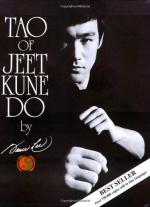
|
| Name: _________________________ | Period: ___________________ |
This test consists of 15 multiple choice questions and 5 short answer questions.
Multiple Choice Questions
1. In what year was Jeet Kune Do published?
(a) 1975.
(b) 1980.
(c) 1973.
(d) 1971.
2. According to Lee, what is achieved by practice to form neural pathways?
(a) Non-attachment.
(b) Non-thinking.
(c) Muscle.
(d) Skill.
3. What does Lee claim a master boxer attacks by?
(a) Thoughts.
(b) Strategy.
(c) Force.
(d) Deception.
4. What does Lee say enables one to assume adaptability to any style?
(a) An inner strength.
(b) Flexability.
(c) Practice.
(d) Formlessness.
5. Lee explains that a dancer requires different warm up exercise _____ and _____ from an older martial arts fighter.
(a) Examples/Models.
(b) Sets/Repetitions.
(c) Times/Types.
(d) Sketches/Illustrations.
6. What concept of enlightenment is used in martial arts?
(a) Bliss.
(b) Solitude.
(c) Zen.
(d) Prayer.
7. The author suggests that the lack of _____ lets things disclose themselves.
(a) Time.
(b) Self-rigidity.
(c) Will power.
(d) Energy.
8. What does Lee consider to be the psychological and physiological conditioning of an individual?
(a) Preliminaries.
(b) Training.
(c) Fighting.
(d) Meditation.
9. In Lee's view, what results from three thousand years of conditioning and propaganda?
(a) A classic martial artist.
(b) An Olympian.
(c) A successful athlete.
(d) A Jeet Kune Do master.
10. Lee teaches that the ripening of an individual with his being is not possible without ______.
(a) Six weeks of training.
(b) Letting go of a need to win.
(c) Self-exploration in free expression.
(d) Understanding the history of martial arts.
11. What is an ability to recognize or provoke the right moment to act?
(a) Speed.
(b) Inspiration.
(c) Intuition.
(d) Timing.
12. What position does Lee consider to be the most favorable and underlies all recommended techniques and skills?
(a) Extended lead.
(b) Poker body.
(c) On-guard position.
(d) Low-line position.
13. What does Lee call a group of routines, ideas, and traditions that defeat freedom?
(a) Religion.
(b) Classical styles.
(c) The daily grind.
(d) Warming up.
14. What response must the opponent be in, according to Lee, in order for the fighter to break the rhythm to catch the opponent off-balance?
(a) Motorset.
(b) Uncoordinated.
(c) Distracted.
(d) Inferior.
15. What is the fragment of time within a cadence that is most suitable for effective action?
(a) Seconds.
(b) Cadence.
(c) Tempo.
(d) Speed.
Short Answer Questions
1. What increases energy cost to cause early fatigue?
2. Perceptual, mental, initiation and performance are types of _____.
3. How many steps does Lee give for throwing one's opponent to the ground?
4. What does Lee claim is the greatest hindrance to proper physical action?
5. Lee teaches that quick hitting with leverage and timing regardless of _____ and _____ is the secret of powerful hitting.
|
This section contains 389 words (approx. 2 pages at 300 words per page) |

|




